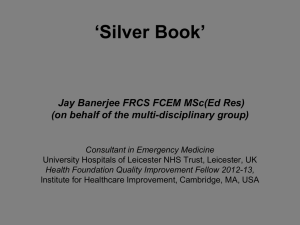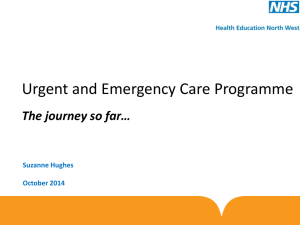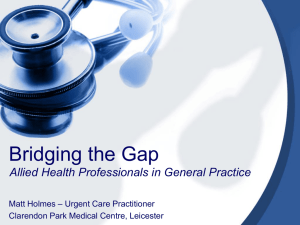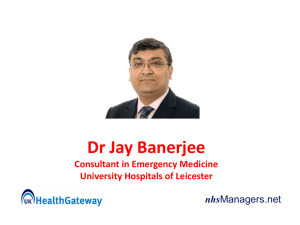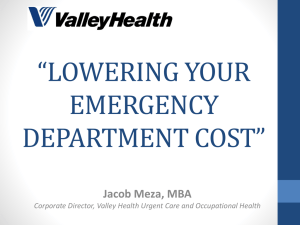Acute medical care of older people outside hospital
advertisement
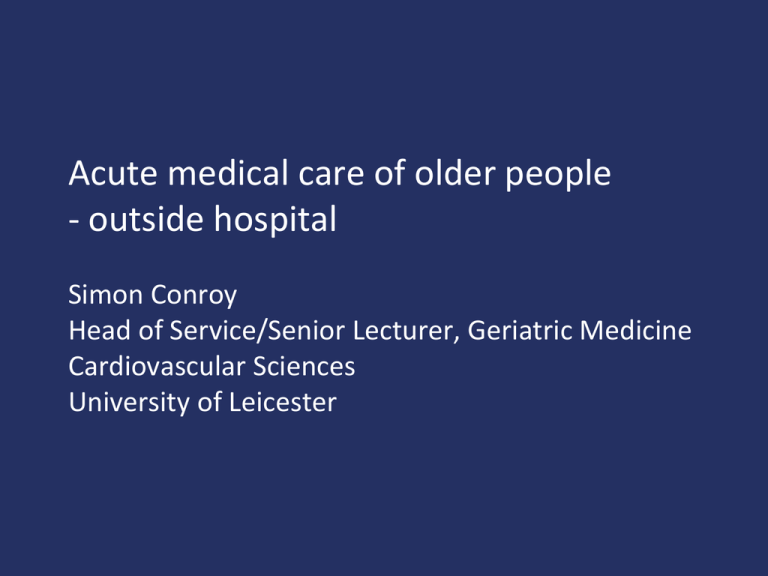
Acute medical care of older people - outside hospital Simon Conroy Head of Service/Senior Lecturer, Geriatric Medicine Cardiovascular Sciences University of Leicester Not an acute medical problem Ageing population Lack of primary care What is intermediate care? Poor social services Inappropriate admissions Patients come out worse than went they went in Ageing population Too many specialists Inappropriate investigations Black hole Inappropriate admissions What is the truth? • Ageing population, increasingly complex care • More attending emergency care – Despite intermediate care etc • Lower threshold for admissions • Coordinated care more challenging as ‘silo mentality’ sets in Some definitions • ‘Unscheduled care’, ‘unplanned care’, ‘emergency care’, ‘urgent care’ • Department of Health: – ‘Emergency Care is an immediate response to time critical health care need. Unscheduled care involves services that are available for the public to access without prior arrangement where there is an urgent actual or perceived need for intervention by a health or social care professional. Urgent care is the response before the next in–hours or routine (primary care) service is available.’ Scope • Emergency care – 999/ED – Not appropriate for community setting • Urgent care – ‘In the eye of the beholder’ – Most urgent care is sub-acute care Urgent (sub-acute) care – who? Urgent (sub-acute) care – who? Urgent care – what? • Non-specific presentations – Falls, delirium • Multiple comorbidities • Polypharmacy – Also under-prescribing • Differential challenge – Communication, discharge support Urgent care - where? • Where there is ready access to: – Skilled assessment – Diagnostics, if necessary – Safe environment – Rehabilitation – Coordinated care Figure 3: Fixed-effects meta-analysis of individual patient data: mortality at 6 months. Shepperd S et al. CMAJ 2009;180:175-182 ©2009 by Canadian Medical Association Urgent care - standards • The Silver Book – http://www2.le.ac.uk/departments/cardiovascular-sciences/people/conroy/silver-book • Membership – – – – – – – – – – – – – Age UK National Ambulance Service Medical Directors Association of Directors of Adult Social Services British Geriatrics Society Chartered Society of Physiotherapists College of Emergency Medicine College of Occupational Therapists Society for Acute Medicine Royal College of General Practitioners Royal College of Nursing Royal College of Physicians Royal College of Psychiatrists Community Hospitals Association Underpinning principles • All older people have a right to a health and social care assessment and should have access to treatments and care based on need, without an agedefined restriction to services • A whole systems approach with integrated health and social care services strategically aligned within a joint regulatory and governance framework, delivered by interdisciplinary working with a patient centred approach provides the only means to achieve the best outcomes for frail older people with medical crises Standards (some) • All older people accessing urgent care should be routinely assessed for: – Pain – Delirium and dementia – Depression – Nutrition and hydration – Skin integrity – Sensory loss – Falls and mobility – Activities of daily living – Continence – Vital signs – Safeguarding issues – End of life care issues Frailty syndromes & urgent care • The presence of one or more frailty syndrome should trigger a more detailed comprehensive geriatric assessment, to start within 4 hours (14 hours overnight) • Frailty syndromes – Falls & immobility – Functional decline – UTI & incontinence – Pressure sores – Delirium and dementia – Polypharmacy (>4 items) – Carer strain Who needs referring to the MDT? Population: • Younger, single system problem Refer to: Relevant service, e.g. mental health, diabetes • Older, single system problem Relevant service, e.g. mental health, diabetes & screen for frailty syndromes • Older, multiple problems, frailty makers Virtual ward/ community MDT Operationalising good practice • Delivering multidimensional assessment & multiagency management • Home based multidisciplinary teams – General practitioners – Community nursing, physiotherapy, occupational therapy, mental health – Specialist nursing – Advanced nurse practitioners – Interface geriatricians – Social care – Voluntary services Does it work in practice? • National Evaluation of the Department of Health’s Integrated Care Pilots; RAND Europe, Ernst & Young; March 2012 Key findings • Horizontal > vertical integration • Process improvements – e.g. more care plans • Professional > patient driven service change – Patients less enthusiastic • No evidence of reduced emergency care use • Reductions in elective care use (in and out-patient) – Case management – Reduced costs Effective urgent community care for older people • Vertically integrated, using strengths of both sectors • Comprehensive geriatric assessment, including social care • Coordinated and communicated Intermediate care Frail older person in crisis SPA – clinical discussion Bed-based rehabilitation/ reablement MDT Triage Trajectory Transfer Liaison Specialist care EFU/ AFU In-patient CGA Summary outcomes for ED Percentage change 2010 vs. 2012 Impact on bed days Despite large increase in older people attending, bed-days only modestly increased Summary • Urgent care = older people • It can be in the community, but: – Needs to be vertically integrated – Holistic & interdisciplinary – Underpinned by robust communication and cooperation

